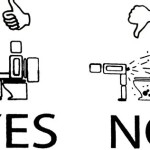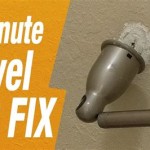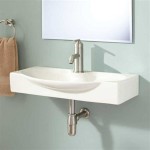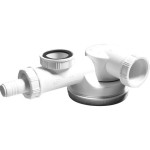How To Clean A Bathroom Floor Without a Mop
Maintaining a clean bathroom floor is crucial for overall hygiene and aesthetics. While a mop is a common tool for this task, it isn’t always the most accessible or preferred option. Circumstances may arise where a mop is unavailable, broken, or simply unsuitable for the specific type of flooring. Fortunately, effective alternatives exist for cleaning bathroom floors without relying on a mop. This article provides a comprehensive guide to these methods, detailing the necessary materials, step-by-step instructions, and important considerations for achieving a spotless and sanitary bathroom floor.
Prior to commencing any cleaning process, it's essential to prepare the bathroom floor. This preliminary step involves removing all loose debris and obstructions. The presence of hair, dust, and other particles can hinder the cleaning process and potentially damage the flooring surface if dragged around. Effective preparation sets the stage for a more thorough and efficient cleaning outcome.
The initial step in preparing the floor is to remove any bath mats, rugs, or other removable floor coverings. These items can trap moisture and dirt, contributing to the build-up of grime on the underlying floor. Furthermore, moving these items allows for unrestricted access to the entire floor surface, ensuring a comprehensive cleaning. After removing the floor coverings, shake them out outdoors to dislodge any accumulated dirt and dust before laundering if necessary.
Sweeping or vacuuming the floor is the next crucial step. A broom with soft bristles is ideal for sweeping tiled or vinyl floors, while a vacuum cleaner with a brush attachment is more suitable for removing dust and debris from grout lines and textured surfaces. Pay particular attention to corners, edges, and areas around the toilet and sink, as these are often hotspots for dirt and grime accumulation. The goal is to eliminate any loose particles that could otherwise be spread around or dissolve into the cleaning solution, rendering it less effective.
Key Point 1: Using a Microfiber Cloth and Spray Bottle
A highly effective method for cleaning bathroom floors without a mop involves utilizing microfiber cloths and a spray bottle filled with a suitable cleaning solution. Microfiber cloths are known for their exceptional absorbent properties and their ability to trap dirt and grime without leaving streaks. This method offers precise control over the application of the cleaning solution, minimizing the risk of oversaturation, which can damage certain types of flooring.
The first step in this process is to prepare the cleaning solution. A variety of options exist, depending on the type of flooring and the severity of the grime. For general cleaning, a mixture of warm water and a mild dish soap typically suffices. For more stubborn stains or disinfecting purposes, a solution of water and white vinegar can be used. However, it's crucial to exercise caution when using vinegar on certain types of natural stone, as the acidity can potentially damage the surface. Always test the cleaning solution on an inconspicuous area of the floor before applying it to the entire surface.
Once the cleaning solution is prepared, pour it into a spray bottle. Lightly spray a small section of the bathroom floor with the solution. Avoid oversaturating the area, as excessive moisture can seep into grout lines and potentially cause damage. Allow the solution to sit on the surface for a minute or two to loosen dirt and grime.
Using a clean microfiber cloth, thoroughly wipe the sprayed area in a circular motion. Apply gentle pressure to dislodge any stubborn stains. As the cloth becomes soiled, rinse it thoroughly with clean water and wring it out before continuing. It may be necessary to use multiple microfiber cloths to effectively clean the entire floor. Regularly change the microfiber cloth as it becomes saturated with dirt to prevent spreading grime back onto the floor.
After wiping the floor with the cleaning solution, use a clean, dry microfiber cloth to buff the surface. This step removes any remaining moisture and helps to prevent streaks. It also restores the shine of the flooring, leaving it looking clean and polished.
For areas with particularly stubborn stains or grime, consider using a specialized grout brush in conjunction with the microfiber cloth. The grout brush can effectively scrub away dirt and mildew from grout lines, which are often difficult to clean with a cloth alone. Dip the grout brush into the cleaning solution and scrub the grout lines gently, then wipe away the residue with a clean microfiber cloth.
Key Point 2: Utilizing a Scrub Brush and Bucket
An alternative method for cleaning bathroom floors without a mop involves using a scrub brush and a bucket of cleaning solution. This approach is particularly effective for heavily soiled floors or those with textured surfaces where a microfiber cloth may not be sufficient to reach into crevices and remove embedded dirt. The scrub brush provides added scrubbing power, allowing for a more thorough cleaning.
Begin by preparing the cleaning solution in a bucket. The same solutions used for the microfiber cloth method, such as warm water and mild dish soap or water and white vinegar, can be used. However, when using a scrub brush, it's important to ensure that the solution is not too concentrated, as excessive suds can be difficult to rinse away and may leave a residue on the floor.
Dip the scrub brush into the cleaning solution, ensuring that the bristles are thoroughly saturated. Wring out any excess solution to prevent oversaturation of the floor. Using a firm, circular motion, scrub the floor in small sections. Apply moderate pressure to dislodge dirt and grime, paying particular attention to areas with heavy staining or buildup.
Once a section of the floor has been scrubbed, use a clean sponge or cloth to wipe away the dirty cleaning solution. Rinse the sponge or cloth frequently with clean water to prevent spreading the dirt back onto the floor. Continue scrubbing and wiping until the entire floor has been cleaned.
After scrubbing and wiping the floor, it's essential to thoroughly rinse the surface with clean water. This step removes any remaining soap residue or cleaning solution, which can attract dirt and leave the floor feeling sticky. Use a clean bucket of water and a clean sponge or cloth to rinse the entire floor. Change the water frequently to ensure that the floor is being rinsed with clean water.
Finally, allow the floor to air dry completely. Open windows or use a fan to speed up the drying process. Avoid walking on the floor until it is completely dry to prevent leaving footprints or streaks.
Key Point 3: Employing Steam Cleaning Techniques
Steam cleaning offers a highly effective and environmentally-friendly method for cleaning bathroom floors without the need for a mop or harsh chemicals. Steam cleaners utilize hot steam to loosen dirt and grime, sanitize the surface, and leave the floor sparkling clean. This method is particularly suitable for tile, vinyl, and laminate floors, as the steam can penetrate into grout lines and textured surfaces to remove embedded dirt.
The first step in steam cleaning is to fill the steam cleaner with water according to the manufacturer's instructions. Deionized or distilled water is recommended to prevent mineral buildup in the steamer. Allow the steamer to heat up to the appropriate temperature, typically indicated by a light or sound signal.
Attach the appropriate cleaning head to the steam cleaner. Most steam cleaners come with a variety of attachments, including a floor head for cleaning large areas and a smaller nozzle for cleaning grout lines and corners. Select the attachment that is best suited for the type of flooring and the specific cleaning task.
Begin steam cleaning the floor by slowly moving the steam cleaner across the surface in overlapping strokes. The hot steam will loosen dirt and grime, which can then be wiped away with a microfiber cloth or the cleaning pad that is typically attached to the floor head. Pay particular attention to grout lines and areas with heavy staining or buildup.
For stubborn stains or grime, hold the steam cleaner nozzle over the affected area for a few seconds to allow the steam to penetrate and loosen the dirt. Then, use a grout brush or scrub brush to scrub the area gently. Wipe away the residue with a clean microfiber cloth.
After steam cleaning the entire floor, allow the surface to air dry completely. The hot steam will typically dry quickly, but it's important to ensure that the floor is completely dry before walking on it to prevent slipping or leaving footprints.
For optimal results, consider pre-treating heavily soiled areas with a mild cleaning solution before steam cleaning. This can help to loosen dirt and grime, making it easier for the steam cleaner to remove. However, avoid using harsh chemicals or abrasive cleaners, as these can damage the flooring surface or interfere with the steam cleaning process.
When using any cleaning method, especially those involving liquids, adequate ventilation is essential. Open windows and doors to ensure proper airflow, which helps to speed up the drying process and prevent the accumulation of moisture. Poor ventilation can lead to the growth of mold and mildew, particularly in damp environments like bathrooms.
Regular cleaning prevents the buildup of grime and stains, making the task easier and more efficient in the long run. Aim to clean the bathroom floor at least once a week, or more frequently if necessary, depending on the level of use and traffic. Consistent maintenance not only improves the appearance of the bathroom but also contributes to a healthier and more hygienic environment.
In conclusion, cleaning a bathroom floor without a mop is entirely feasible with the right tools and techniques. Whether using microfiber cloths, a scrub brush, or a steam cleaner, the key is to prepare the floor properly, select the appropriate cleaning solution, and thoroughly rinse and dry the surface. By following the steps outlined in this guide, a clean and sanitary bathroom floor can be achieved, even without the use of a traditional mop. Remember to always test cleaning solutions on an inconspicuous area before applying them to the entire floor and prioritize safety by ensuring adequate ventilation during the cleaning process.

How To Clean Bathroom Floor Without Mop

How To Clean Bathroom Floor Without Mop

How To Clean Bathroom Floor Without Mop House Fast

How To Clean Bathroom Floors Easiest Step By Guide

How To Clean Your Floors Without A Mop Vacuum All In One

How To Wash Your Bathroom Floor 13 Steps With Pictures

How To Wash Your Bathroom Floor 13 Steps With Pictures

How To Clean My Bathroom Floor Without Mop Tiktok Search

Everything You Need To Know On How Deep Clean Your Bathroom

How To Clean Hardwood Floors Reviews By Wirecutter
Related Posts







